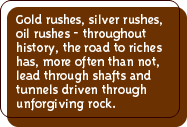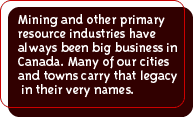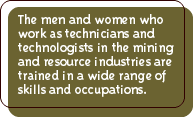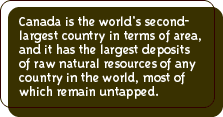|
"Gold!" screamed the newspaper headlines in the summer
of 1897. Men had built empires, fought wars and died searching for the
shiny yellow metal for thousands of years, and in August 1896, along
the banks of a tributary of the Klondike River in the Yukon, prospectors
discovered one of the richest gold deposits in Canadian history. It
took almost a year for the news to work its way from the Klondike, across
the Rockies to Fort Fraser and then down the Fraser River to civilization.
But when the news finally broke, the rush was on. By 1900 there were
more than 30,000 people in and around Dawson City, the boomtown that
grew on the foundation of Klondike gold.
For a few years, fortune seekers panned the Klondike
and its tributaries, and some became fabulously wealthy almost overnight.
Soon, however, the rush came to an end as lone prospectors gave way
to scientific mining methods, but the gold remained, and by 1966, when
the mines themselves finally closed down,  the
region had produced almost $380 million of the precious metal. the
region had produced almost $380 million of the precious metal.
Gold rushes, silver rushes, oil rushes - throughout
history, the road to riches has, more often than not, lead through shafts
and tunnels driven through unforgiving rock. Indeed, the civilization
we enjoy today simply would not exist had we not harnessed the elemental
resources of the earth itself. In the late 19th century petroleum was
added to the mix as the first oil wells in Canada, near Sarnia, Ontario,
started to pump black gold from the ground.
Our cars run on petroleum. Iron, coal and manganese
give us steel. Computers would not exist without gold and platinum and
silicates extracted from huge quarries. Every child knows what glories
lie in the mineral cores of rocks split open on a summer afternoon.
And it's those minerals that today's scientific prospectors and mining
engineers seek to extract from the earth.
Mining and other primary resource industries have always
been big business in Canada. Many of our cities and towns carry that
legacy in their very names. Coppermine, Northwest Territories is self-explanatory.
Red Lake, Ontario is named after the colour given off by underwater
gold deposits. Timmins,  Ontario
is named after a mining executive and Cobalt, Ontario is named after,
well…cobalt. Ontario
is named after a mining executive and Cobalt, Ontario is named after,
well…cobalt.
The mining, quarrying and oil industries have also
been one of the few sectors of the Canadian economy that have continued
to grow consistently. Apparently unaffected by economic crises, recessions
and the devaluation of the Canadian currency - in fact, a low loonie
only helps the business - these industries grew 41.5 percent between
1984 and 1997. And we musn't forget that primary industries do not exist
in a vacuum. Every mineshaft sunk into an ore vein and every oil or
natural gas well drilled requires whole battalions of technicians and
technologists across several disciplines, including Geomatics, Civil,
Mechanical, Petroleum and Mineral.
But the business is changing, and this is reflected
by the way the number of people employed in mining, quarrying and the
oil industry dropped by about five percent in the same period. Since
the 1950s, a revolution in resource extraction technologies has resulted
in greater volumes of resources being extracted every year by fewer
and fewer workers at much reduced costs. Aluminum is a case in point:
once more valuable than gold because it was so difficult to extract
and refine, the light, strong metal is everywhere today. We use it in
our cars, trains, planes and households. It's so inexpensive that we
even use it for sandwich wrapping and beverage cans.
The days are long gone when miners equipped with lighted
helmets, picks and shovels descended the mines to carve riches  from
veins of mineral treasure, or when wildcatting oilmen drove shafts willy-nilly
through the plains of Alberta. Miners and petroleum workers today are
among the most highly trained specialists in the world, and more often
than not, they are trained Petroleum and Mineral Technicians and Technologists. from
veins of mineral treasure, or when wildcatting oilmen drove shafts willy-nilly
through the plains of Alberta. Miners and petroleum workers today are
among the most highly trained specialists in the world, and more often
than not, they are trained Petroleum and Mineral Technicians and Technologists.
The men and women who work as technicians and technologists
in the mining and resource industries are trained in a wide range of
skills and occupations. They are the operators of high-tech mining and
drilling machines. They are as likely to be experts in the application
of geophysics, seismology and organic chemistry.
Our society has come to realize just how finite and
precious these resources are. The stakes are higher now than they were
in 1897, when it seemed that the Klondike was a river of gold that would
never run out, and with that realization has come a greater emphasis
on efficiency, precision - and consequently skill.
Equally important has been the resource industries'
growing environmental consciousness. And that consciousness has created
a whole new class of occupations. The days when a company could strip-mine
a mountain without considering the operation's impact on nature and
wildlife will never be seen again.  The
preparation of environmental impact studies and monitoring of waste
from slag and runoff have become as central to the industry as the process
of mining, quarrying and drilling itself. This is the domain of Environmental
Technicians and Technologists. The
preparation of environmental impact studies and monitoring of waste
from slag and runoff have become as central to the industry as the process
of mining, quarrying and drilling itself. This is the domain of Environmental
Technicians and Technologists.
The future of Canadian resource industries looks bright.
Even as we move away from fossil fuels and coal to cleaner energy products,
new demands for other minerals and resources will doubtless continue
to grow. Canada is the world's second-largest country in terms of area,
and it has the largest deposits of raw natural resources of any country
in the world, most of which remain untapped.
The gold rush days of the past may be long over, but
the future of one of our greatest industries looks as bright as polished
gold.

|